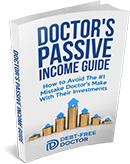What To Do With 50K Each Year – A 10 Year Look At Passive Investing
I recently posed this question on DentalTown.com which is the largest forum for dentists:
“For those that have been practicing for 5+ years & knowing what you know now regarding finances and investing, what would you do differently if you could go back in time?”
As you can probably guess, my response had to do with investing in real estate syndications much earlier in my career.
We’ve lived relatively frugally throughout the years and I’ve made it a point to save money on a consistent basis.
“Successful people do consistently what others do occasionally.”
I can assure you that if we’d known about real estate syndications and the magic of compounding back then well let’s just say that I wouldn’t be dealing with patients anymore. 🙂
What’s great about someone with a six-figure+ income is that it’s easy to save $50K or more each year.
I had a call this morning with a new Passive Investor Circle member that asked me what to do with 50K. When I told him he may want to look into syndications he then wanted to know what type of returns he could get if he were to invest 50K a year for the next few years.
Today, I’m going to break that answer down for you.
Don’t Miss Any Updates. Each week I’ll send you advice on how to reach financial independence with passive income from real estate.
Sign up for my newsletterWhat Happens When You Invest $50,000 Each Year In Real Estate Syndications
Year #1
It’s very exciting saving up and investing in your first syndication. The first deal is probably the one you’re going to spend the MOST amount of time researching which is good and bad. The good is that it’s always great to learn about some new type of investment.
Especially one that can replace your income now which give you options.
The bad is that the first year of investing in each deal isn’t that thrilling as not much happens until after the deal closes.
For our example today, let’s say that you’ve decided on investing $50K in a 250-unit value-add apartment complex in Charleston, South Carolina.
A few months after investing you then receive your first monthly distribution check for $333 which is roughly an 8% annual return.
Some of the earlier deals I invested in were paying this amount.
Soon afterward, you begin to receive $333 per month in distribution checks, which is about 8%, an average for our standard deals.
Year #2
Many new investors, myself included, are interested in learning more about the tax benefits of investing in syndications and how the process works. Typically in the Spring, the sponsor of the deal will distribute a Schedule K-1 tax document. This is usually uploaded in your Investor Portal or one will be mailed to you.
The K-1 is the tax document that shows your income and losses from your investment which you’ll need to pass this along to your CPA.
For our example, we’ll call the Charleston property from year #1 Property A.
Your K-1 is going to open your eyes to what the magic of accelerated depreciation can bring via a cost segregation study to your taxes.
The first K-1 shows a nice, hefty paper loss for Property A even though you’ve been receiving all of those cash flow checks.
These losses will allow you to offset those distributions so they’ll basically be tax-free.
Related Article: Tax Free Wealth
Now that you’ve gotten comfortable with investing in your first syndication, it’s time to invest another $50,000 into Property B.
By doing this, it increases your monthly cash flow from real estate syndication investments to $666 ($333 from each property, A and B).
Year #3
The Spring of the third year is the first time that you’ve ever looked forward to tax season.
Why?
It’s due to the fact that you’ll receive not one but two K-1 tax forms showing all of the write-offs thus far.
This gets you pumped up even more which reminds you that it’s time to invest another $50K into your third syndication deal which we’ll call Property C.
Shortly after investing, you then begin to receive 3 monthly distribution checks each totaling about $1000.
Congratulations! You’ve increased your yearly income by $12,000 annually.
Year #4
Roughly midway through the fourth year of investing, you receive word that the first investment (Property A) has completed all of their renovations.
Remember this is a value-add property where the apartment is purchased based on the possibility of improving and then selling later for a higher price.
The sellers are excited and are ready to move forward with listing it to sell. Because this property is in a hot submarket in a growing metro area (Charleston), the listing gets a ton of attention and is soon purchased.
At this time you receive the original $50K investment from Property A plus an additional $25,000 in profits is received. Sweet!
Due to the fact that you’re still working full-time, you decide to reinvest all of your returns from Property A ($75,000), plus the $50,000 you’ve saved in year 4, into Property D.
You now have a total of $225,000 invested, across three syndications, each with a preferred return of 8%. This means that you’re now expecting about $18,000 per year in cash flow distributions ($1,500 per month).
Year #5
In year 5, Property B (your investment from year 2) has completed its renovations and is sold. You receive your original $50,000, plus an additional $25,000 in profits.
This is starting to get fun now isn’t it?
Year #4’s deal worked out so well that you decide again to combine that $75,000 with the $50,000 you save in year 5, and you invest that all in Property E.
This investment brings your total invested capital to $300,000.
At this point the monthly distribution checks from the cash flow total $2,000.
Join the Passive Investors CircleYears #6 & 7
Now that you’re starting to get used to passively investing in syndications, let’s speed things up.
In year 6, Property C is sold (the original investment was $50,000), and property D is sold in year 7 (the original investment was $125,000).
At this point, saving $50,000 a year is becoming much easier because the excess cash flow from the distributions are growing at a nice pace.
This is perfect time to enjoy yourself with a nice beach vacation with the kids, you deserve it!
Each year, you add $50,000 of your savings to the returns you receive from those exited deals.
So in year 6, you invest $125,000 into Property F, and in year 7, you invest $125,000 into Property G.
At this point, the total amount invested is $487,500 and each month you receive six distribution checks (for Properties B-G), totaling $3,250 per month, or about $39,000 per year.
You’re now bringing in enough money to the point you may want to rethink working full-time. It feels good to have added an invisible worker generating income but not adding any extra expenses.
And remember, because of all the depreciation, you’re continuing to show paper losses allowing your excess cash flow to continue tax free.
Years #8 – 10
You look up and can’t believe that another three years have passed. I guess it’s true that time DOES fly by when you’re having fun.
Let’s recap what’s happened up to this point
For the past ten years, you’ve been investing $50,000 annually in passive real estate. The kids are older but you’ve been able to enjoy attending their sporting events and traveling with them. You feel as if you’re maturing into a confident real estate investor.
The first six deals have gone full-circle adding nice returns to reinvest. You’ve decided to not touch the money and let it continue to snowball as you’re still working in your career.
Looking back over these ten years, you pat yourself on the back as saving a half a million dollars is no small task.
You avoided what most doctors and other high-income earners do at this point and upgrade their lifestyle with expensive cars or a costly home. Not you. You had a mission and stuck with it. Great job!
Let’s pause and crunch some numbers to see how things have gone thus far.
In each of years 8, 9, and 10, deals exited and you decided to continue to reinvest the returns. At the end of year 10, you have over $880,000 invested in multiple real estate syndications across numerous markets producing $70,500 in passive income each year.
Let that sink in for a moment.
By sacrificing only ten years and delaying gratification, you have close to $6,000 of tax free income hitting your account each month. Solid!
This example shows you the potential power of those wanting to know what to do with $50K each year.
If you keep this up, do you think you could change your family’s future wealth?
Proverbs 13:22: “A good man leaves an inheritance to his children’s children.”
Summary
The above 10 year example is just that, an example. We all know that real-life investing is not as neat and clean as what we discussed today.
Nobody can predict exactly when a deal is going to exit and cash flow returns might not be exactly 8%.
The point I’m trying to make is that it’s not likely you would see these exact numbers. Granted it’s possible that your deals could be slower to grow but it’s also possible that their growth could be faster.
Either way, I wanted to show you a different approach to investing that can dramatically change the course of your financial future.
Investing in real estate syndications is similar to farming. Seeds are planted first then time and patience is needed to reap the benefits of the harvest.
If you’re looking for a get-rich-quick scheme then sorry, this isn’t for you. Actually it’s quite the opposite. Investing in real estate syndications is a long-term strategy that should result in building wealth slowly but steadily over time.
My purpose today was to hopefully open your eyes to a 10-year plan that could bring you something bigger and better than you were on track to receive before reading this article.
The great thing about your position as a high-income earner is the fact that these numbers could easily be doubled or tripled as you have the ability to invest more that $50K per year.
Are you ready to get started in passive investing?
Join the Passive Investors Circle today.
Join the Passive Investors Circle







